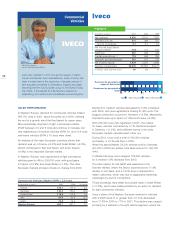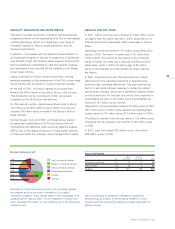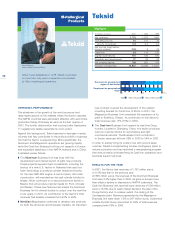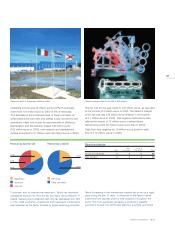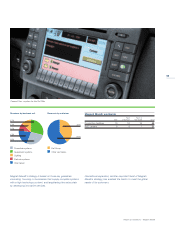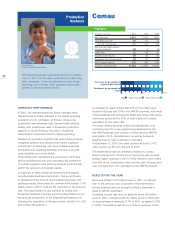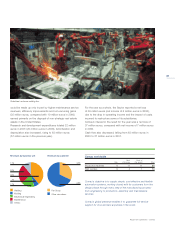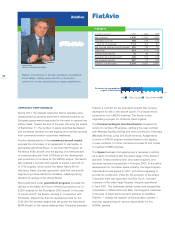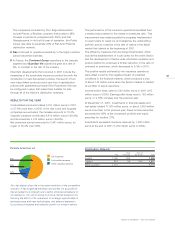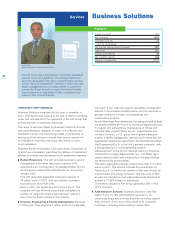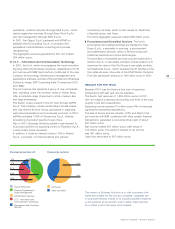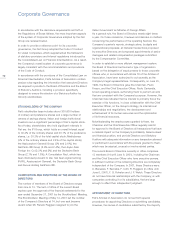Chrysler 2001 Annual Report Download - page 62
Download and view the complete annual report
Please find page 62 of the 2001 Chrysler annual report below. You can navigate through the pages in the report by either clicking on the pages listed below, or by using the keyword search tool below to find specific information within the annual report.
Revenues by geographical
region of destination
050 100%
Rest of the world
Rest of Europe
Italy
62
Aviation
(in millions of euros) 2001 2000 1999
Net revenues 1,636 1,491 1,361
Operating income 186 143 109
as a % of revenues 11.4 9.6 8.0
Net income before minority interest 425 83 61
Cash flow 514 173 145
Capital expenditures 41 36 42
Research and development 132 104 128
Net invested capital 587 71 163
Number of employees 5,243 5,362 5,590
Highlights
Saverio Strati,
FiatAvio’s Chief Executive Officer.
FiatAvio is continuing to set new standards of excellence
in the design, testing and production of propulsion
systems for various aeronautical and space applications.
FiatAvio
OPERATING PERFORMANCE
During 2001, the markets where the Sector operates were
characterized by growing demand for defense products, as
European governments responded to the need to replace their
military fleets. Toward the end of the year, following the events
of September 11, the number of space launches decreased,
and worldwide demand for new engines and overhaul services
from commercial aviation customers weakened.
Positive developments in the commercial aircraft market
included the conclusion of an agreement to participate, in
partnership with Rolls Royce, in the Trent 900 Program for
the Airbus A380 aircraft, and the signing of a memorandum
of understanding with Pratt & Whitney for the development
and production of modules for the PW600 engine. The Sector
also finalized a contract with Agusta to supply a second lot
of T700 engines, which power the Italian Navy’s EH101
helicopter. Sales of power generation units that use aircraft
engines to produce electricity increased, reflecting strong
demand for energy in the United States.
Work performed under government programs included the
delivery to the Italian Air Force of the first production run of
EJ200 engines for the Eurofighter 2000 aircraft. In the area
of trainer aircraft, the Sector, working in cooperation with
Honeywell, shipped the first two development kits for the
F124 GA 200 turbofan engine that will power the Aermacchi
M346 aircraft. In the marine defense field, Fincantieri awarded
FiatAvio a contract for the propulsion system that is being
developed for Italy’s new aircraft carrier. This vessel will be
powered by four LM2500 turbines. The Sector is also
negotiating a project for Orizzonte Class frigates.
The Commercial Engine Overhaul Division increased its
orders to overhaul JT8 engines, adding a five-year contract
with Midwest Express Airlines and other contracts in Indonesia
(Mandala Airlines), Libya and South America. Assignments
to work on PW100 engines doubled thanks to the signing
of new contracts. In China, the Sector booked its first orders
to overhaul CFM56 engines.
The Space Business Unit experienced a decrease in activity
as a result of problems with the upper stage of the Ariane 5
launcher. These problems have since been resolved, and
launches resumed successfully in February 2002. In a positive
development for the Italian space industry, the Vega Program
memorandum was signed in 2001, with France agreeing to
provide its contribution. Plans for the evolution of the Ariane
5 launcher were also approved, and ELV S.p.A., the lead
company of the entire Vega Program, became operational
in April 2001. The preliminary design review was successfully
completed in collaboration with ESA, the Program’s customer.
In the area of liquid-fuel propulsion systems for satellites,
FiatAvio — already the supplier of the propulsion system —
was also assigned launch service responsibility for the
SICRAL satellite.


